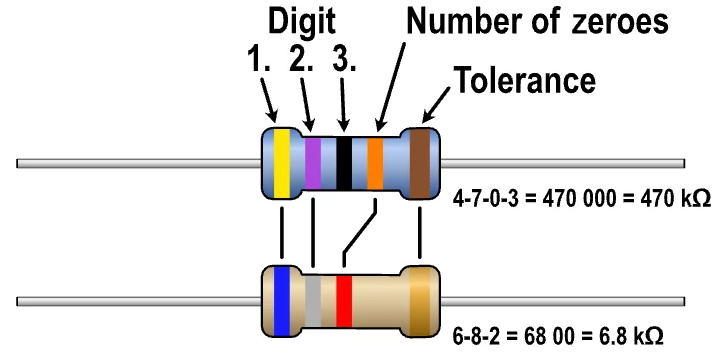
In the vast landscape of electronic components, resistors serve as foundational elements governing current flow and voltage division within circuits. Among these, the 1 Megohm resistor stands as a notable component due to its widespread utility across various applications. Understanding the color code associated with this resistor is not just a necessity but a gateway to comprehending its value, tolerance, and significance in electronic designs.
The Significance of Resistance in Electronics:
Resistance, measured in ohms (Ω), acts as a critical parameter in electronics. It determines the degree to which a material opposes the flow of electric current. Resistors, as passive components, control current and voltage levels within a circuit, thereby enabling the precise functioning of electronic devices.
The Anatomy of the 1 Megohm Resistor Color Code:
A 1 Megohm resistor typically consists of four color bands that signify its resistance value:
First Band (First Digit): This band represents the first digit of the resistance value. For a 1 Megohm resistor, this band embodies the number 1.
Second Band (Second Digit): The second band denotes the second digit of the resistance value. In the case of a 1 Megohm resistor, this band represents the number 0.
Third Band (Multiplier): The third band indicates the multiplier or the number of zeros to be added after the two digits from the first and second bands. For a 1 Megohm resistor, this typically corresponds to a color such as green, symbolizing a multiplier of 10^6.
Fourth Band (Tolerance): If present, the fourth band specifies the tolerance level, indicating the permissible deviation from the specified resistance value. Commonly, this band might be gold (indicating ±5%) or silver (indicating ±10%) for standard resistors.
The Color Coding System:
Resistor color bands serve as a visual representation of the resistance value, tolerance, and sometimes the temperature coefficient of a resistor. For the 1 Megohm resistor, decoding these bands is pivotal to discern its specifications accurately.
The Color Bands and Their Corresponding Values:
Understanding the color code requires familiarity with the color-to-value mapping. Each color represents a numerical value, facilitating the determination of the resistance value:
Black: 0
Brown: 1
Red: 2
Orange: 3
Yellow: 4
Green: 5
Blue: 6
Violet: 7
Gray: 8
White: 9
Applications and Utility of 1 Megohm Resistors:
The 1 Megohm resistor finds its application in various electronic circuits due to its versatility:
Voltage Dividers: Crucial in dividing voltage levels within circuits.
Sensor Interfaces: Used to interface sensors with microcontrollers and digital systems.
Signal Conditioning: Plays a role in conditioning signals for proper processing.
Filter Circuits: Utilized in designing filters for specific frequency responses.
Variants and Advanced Configurations:
While the standard 1 Megohm resistor predominantly follows the four-band color code, variations exist. Some resistors incorporate additional bands, such as a fifth or sixth band, denoting parameters like the temperature coefficient or specialized tolerance levels.
Precision, Tolerance, and Circuit Design:
In electronic circuits, precision and tolerance are paramount. The tolerance band in the color code ensures that the actual resistance falls within an acceptable range, safeguarding against circuit malfunctions caused by deviations from the specified value.
Conclusion:
The comprehension of the 1 Megohm resistor color code serves as a linchpin for engineers, hobbyists, and enthusiasts navigating the realm of electronics. Its role in controlling current flow, voltage division, and signal conditioning underscores its significance in myriad electronic applications.
Final Reflections:
Grasping the intricacies of the resistor color code system, particularly in the context of the 1 Megohm resistor, unveils the elegance of precision engineering in electronics. The ability to decipher these color bands is not merely a technical skill but a gateway to unlocking the potential of electronic circuitry, paving the way for innovation and advancement in the field.
